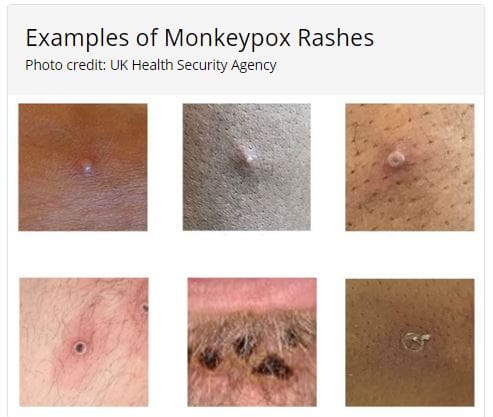

A 41-year-old New Castle County man tested positive for the monkeypox virus this week.
It’s the state’s first case of the communicable virus, which has already been found in states around the country.
The man did not report any travel or exposure to someone known to have the virus, called MPX for short, but is believed to have been exposed after intimate contact with an individual in early July, according to the Delaware Division of Public Health.
The individual, who the state will not name, is self-isolating and the state is trying to track his close contacts.
Public Health also is working with the Centers for Disease Control to confirm the best course of treatment.


This UK Health Security Agency graphic shows some of the ways monkeypox can appear.
“The Delaware Division of Public Health has prepared to respond to MPX cases,” said Dr. Rich Hong, interim director of Public Health. “As we work to confirm our first case in the state, we encourage Delawareans to be aware of being in close intimate contact with individuals who have rashes or flu-like symptoms. We will continue to monitor this situation closely.”
MPX can make you sick, causing a rash, which may look like pimples or blisters, often with an earlier flu-like illness.
Transmission occurs when a person encounters the virus from an animal, human, or materials contaminated with the virus.
The virus enters the body through broken skin (even if not visible), respiratory tract, or the mucous membranes (eyes, nose, or mouth).
The overall risk of MPX is low, generally caused by close intimate contact, the state press release said.
However there are other ways it can spread including:
- Direct contact with the infectious rash, scabs, or body fluids.
- Respiratory secretions during prolonged, face-to-face contact, or during intimate physical contact, such as kissing, cuddling, or sex
- Touching items (such as clothing or linens) that previously touched the infectious rash or body fluids
- Pregnant people can spread the virus to their fetus through the placenta
- Infected animals, either by being scratched or bitten by the animal or by preparing or eating meat or using products from an infected animal.
The incubation period of the illness (time from infection to symptoms) is typically seven to 14 days but can as long as 21 days. The illness itself typically lasts two to four weeks and is rarely fatal. People who do not have symptoms cannot spread the virus to others.
Monkeypox signs, symptoms
The symptoms of MPX are similar to, but milder than, the symptoms of smallpox. They usually start within 3 weeks of exposure to the virus.
Most people who contract the virus will develop a rash, and some will develop flu-like symptoms beforehand. The flu-like symptoms may include fever, headache, muscle aches and backache, sore throat, cough, swollen lymph nodes, chills, or exhaustion.
If someone has flu-like symptoms, they will usually develop a rash one to four days later.
If you suspect you are experiencing any symptoms associated with monkeypox you should immediately contact your doctor, avoid being intimate with other, make a list of contacts within the last 21 days and self-isolate until all lesions have resolved, the scabs have fallen off, and a fresh layer of intact skin has formed.
Currently, there is no specific treatment for monkeypox virus infection. Instead, smallpox vaccine, antivirals and vaccinia immune globulin are used.
CDC recommends vaccination for people who have been diagnosed with or exposed to MPX and people who are at higher risk of being exposed to the virus, including:
- People who have been identified as a contact of someone with the virus
- People who are aware that one of their sexual partners in the past two weeks has been diagnosed with the virus
- People who had multiple sexual partners in the past 2 weeks in an area with known MPX
- People whose jobs may expose them to MPX such as laboratory, and some health care or public health workers


Share this Post









